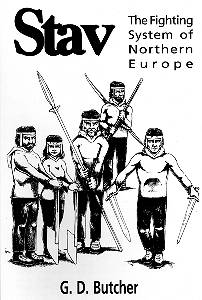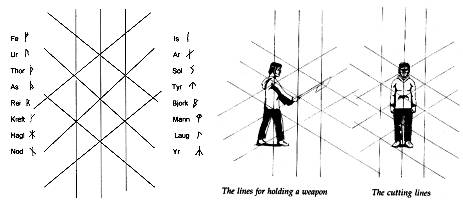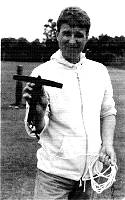The Fighting System of Northern Europe

G.D. Butcher
Stav Marketing and Publishing, 1995.
"Stav is a system to train the mind to see reality. The underlying concept of reality is the web which holds everything together in all dimensions including time."
This book deals with Stav, the puzzling "ancient secret family religion/martial tradition from Northern Europe".
I found this book difficult to review, as most of it is totally implausible. The book is also very short, and rather shallow in some ways, and (apparently) not a very good presentation of the system. I got some feedback on the first version of this review from Stav teacher Shaun D. L. Brassfield-Thorpe, which clarified some of the more obscure parts of the book.
The history section of the Stav book is (like most of the book) very sketchy. First there is the claim that Stav goes back to before 800 and the Vikings etc, but was somehow maintained as a secret until the current "inheritor" Ivar Hafskjold decided to spread the word.
While many martial art styles contain some sort of 'secret', it is however very implausible that the very existence of a style could remain secret for more than 1000 years. In the Eastern martial arts, so-called secrets mostly developed only after schools became commercial enterprises in time of peace. There was never much need for secret martial family traditions in any part of Europe, since we have been almost permanently at war since the times of Pericles or thereabouts.
The explanation offered is that the Stav philosophy has pagan origins and had to remain secret to avoid persecution by the church. However, this would make Stav a religion or philosophy rather than a martial art.
When a system is claimed to be 1000 years old, this raises some questions. Since the system was supposedly kept secret, there is probably no surviving proof of its history; even if Ivar inherited it from his family, it is entirely possible that his great-grandfather made up the whole thing in 1900.
But obscure origins are not uncommon for martial systems. More importantly however, the book is completely vague on what exactly was inherited, and what was, let�s say, reconstructed or added later. Apparently Ivar learnt 'something' from elder family members, but the book doesn't say whether this included the 5 principles based on an old Norse caste system and/or his Tai Chi-like rune-based stances. One interview on the net specifically states that his teachers were too old to really show him the physical side of Stav, so he makes up many of the actual techniques to illustrate the principles as he goes along.
Shaun D. L. Brassfield-Thorpe clarifies this:
As far as the martial side goes, aside from the 16 rune-stances which are the basis of just about everything we do, the "core" aspects of the system are all drawn from the tradition as Ivar learnt it in Norway; these are 5 solo exercises with the staff (or in a single rather than double handed form, with a stick; there is some variation between the double handed staff and single handed stick but the methods are very similar) and 5 partnered exercises - the attacker (armed with an axe) making one of two forms of attack upon the defender, who is armed with a staff. These are related to the 5 "classes" and the 5 Norse elements (earth, water, fire, ice, wind) - The 5 partnered staff exercises in Graham's book are these exercises. To be perfectly honest, in some ways this could be considered "the whole of the martial art" of Stav (it might not seem like much, but it is basically enough!). Traditionally i.e. in Norway, aside from regular practice of the stances and the exercises I have mentioned here, the rest of the training consisted of "making it up as you go along"; basically the idea was (and still is!) that having learnt the 5 principles, one then tests these in various ways. This basically means that the attacker makes an agreed set attack (there are many & various options of what he might do of course) and the defender tests his defence against this (aside from with raw beginers in early training, the attacker is expected to counter any defence if at all possible - we keep this as "real" as possible and don't encourage "co-operation" between attacker & defender). Usually what was done was the defender would pick one of the 16 runes (and one of the 5 principles) and attempt to devise a defence based upon this, then test whether or not this works against a commited attack. Ivar learnt 19 specific defences of this kind from his family (I won't go into why 19, as that would be somewhat complicated!) although a) I don't think any of us (his personal students) actually use these as such in our teaching; b) Ivar has in fairness possibly adapted these due to his Japanese training (he says himself that having first learnt much of this around 50 years ago, he really can't be certain how much of the technical aspects he may have unconsciously altered) and c) these are basically just considered "examples" of what could be done (they all use the rune-stances and the 5 principles, but alternative "techniques" are just as valid). The staff was considered the "core" weapon (with the stick for single-handed weapon training) i.e. from the use of this one could adapt ones method to any other weapon, whereas if one trained in only e.g. the axe (where there is a tendacy to rely upon the blade not the manipulation of the line, and where there is not much option for e.g. reversing the weapon, end over end) then one could not develop "transferable skills" in the same way. This said, anyone might choose to specialise in a weapon for whatever reason.
When Ivar went to Japan and trained in Japanese arts, he basically developed his technical ability through training in these arts. I do not doubt his appreciation of the principles involved in Stav developed also! But basically he didn't change them to fit the Japanese methods.
When Ivar started teaching us (myself, Graham, David and Ronayne), he initially taught us basically as I have outlined above, plus a few solo staff exercises from Jo-Jitsu that he thought were especially useful. When we got on to the "making it up as you go along and testing this" side of training, Ivar naturally enough would suggest or show us various options for how one could use a stance or principal in a given situation. These were quite undoubtedly influenced by Ivar's Japanese training, some I gather being based upon Jo-Jitsu techniques, others of Ivar's invention but nevertheless influenced by his Japanese experience. We trained with exercises of this nature that Ivar had given us, and also developed our own applications and tested these against him (needless to say, some worked, most didn't!); our own improvisations were in fairness no doubt due both to our Stav training and also to prior experience in a range of other arts - but all of this was done with the intention of testing our use of the Stav principles.
So, to wind up a lengthy answer, the principles are Norwegian, much of the technical aspects we were originally taught by Ivar (which we all consider somewhat discardable as they are basically just illustrative and can be varied, adpated, etc) are based upon Ivar's joint knowledge of both the Norwegian art and his extensive training in Japan.
Let's look at some Stav theory:
Techniques are vehicles to carry the student towards an appreciation of prinicple.
The first fundamental principle of Stav is that we work with the line, not the weapon. The weapons we train with are simply tools to assist us in discovering the lines and learning to 'see' them. The lines I refer to are the lines of the web of wyrd, the structure which holds the universe together in many dimensions.

Students of Stav learn to use their web to maximum effect and to see the weakneses in the web of others. To teach this there are simple exercises. The basic cuts with the axe are performed not as a method of just seeking to strike a physical object, but as a means of cutting though the lines of a partner's web. The attacker advances over at least six paces and then cuts through the defender's arc of defence. The defender learns to take evasive action with a counter attack to an effective attack, or deflect a weak one. To build up to this the attacker may walk in with the axe already extended and seek to force the defender's axe off the line. It may seem like a trial of physical strength but a small person with a strongly focused will is always able to deflect the attack of a larger person if their will is not focussed. Which brings me to the second principle, Stav training aims to bring about a unity of mind, body and spirit.
The third principle is that there are five levels of response to any situation which relate to the five classes, levels or principles of Stav. We work with all six weapons of the martial aspect of Stav, the cudgel, axe, scramasax, long-sword, spear and staff. For each weapon there are five two person forms each one of which seeks to apply the five principles described above.
Note that the weapons include a two handed sword which is unlikely to originate from 800, and such fancies as Thor's throwing hammer... Shaun D. L. Brassfield-Thorpe explains the longsword and hammer thus:
Anyway, back to the use of the two-handed sword. Ivar has always maintained that Stáv is a system of principles, not techniques, and that when the principles are understood, then they can be used with any weapon. Several of us have played around with other weapons (i.e. of types not found in Stáv traditionally) and it is undoubtedly true that the principles are universal (e.g. I have done a little work with broad-swords of various types and the Stáv principles remain ever the same, indeed most of the techniques we use are pretty much interchangeable). The main reason that the Long-sword has been introduced is really that everybody seemed to like it...
...We have never in any way deliberately attempted to suggest that this specific form of sword was traditionally used by the Hafskjold family through many generations, indeed we have pretty much publicly stated this was not the case ...
With regard to the hammer, frankly we consider it largely a "curiosity" weapon. No one in the Hafskjold family has actually trained seriously with this weapon in living memory. Frankly, we tend to think of the hammer as either being "a bit of harmless fun" or as a weapon one would have to specialise with, as its mode of use is unakin to other weapons; the staff, spear, axe, sax etc teach transferable skills that rely upon the same principles and can easily be adapted for use with other weapons - the hammer does not. It is a traditional weapon, but it is not one we actually spend a lot of time dwelling upon.
The book mentioned that Ivar Hafskjold spend 10+ years in Japan learning "ken, jo, and aikijutsu, mostly Shindo Musu (sic) ryu and Takeda ryu". Unfortunately none of my Japanese budo contacts ever heard of him, so I got no independent reports on him from that side. The techniques in the book do look a lot like jodo and aiki, and are most likely from Japanese origin. Shaun again explains:
Ivar's main reason for choosing Jo-Jitsu as an art to study and compare was that this was the closest art he could find to his own family's system. By training in Japan he was able to test his family's (living) system against other living traditions.

Ivar with Thor's throwing hammer
Without evidence to support its extraordinary claims, it is very difficult to accept the history claimed for Stav. At least the current development of the technical side of the system can be attributed mostly to Ivar Hafskjold himself (not that there is anything wrong with that) - this is not disputed by Stav practitioners. The explanation offered is that Stav is a living, evolving tradition - while this argument could be valid in Japan for example, the existence of such 'living' traditions of martial systems using training with obsolete weapons to 'train the mind to see reality' is completely undocumented here in the West.
Supposing Stav originated with Ivar, why would he chose to fabricate a system? If most of the technical basis for Stav derives from his background in Japanese arts, why not teach these arts as such? Undoubtedly the secret Viking warrior art is more likely to attract the curious, but why would one want to? A possible motivation could be the desire for money. However, the prices for educational videos, equipment and seminars suggest that making money is not the main object. For example, a week long seminar with the founder and 3 top students is only £120 sterling including food and lodging - according to this site. And these days it seems that a new, modern art of rhythmic cardio-stav would be far more lucrative than supposedly ancient stances.
Power is another possibility. When one has experienced the authority the Japanese enjoy over their arts, it may appear attractive to have your own. In this regard, Stav does raise some concern, as it seems to share some characteristics with certain weird martial arts "cults". The curious might join to learn to kick ass like the Vikings, but soon they may be involved with runes, Norse gods, the web of Wyrd, and claims of healing powers involving energy flows. Again, some Stav students have informed me that Ivar is not that kind of "Master".
So I'm afraid I can't really draw any conclusions to this review. Of course it would be impossible (and unfair) to judge a system such as Stav based just on a (very) little book.
Stav instructor Shaun D. L. Brassfield-Thorpe invites anyone with Stav-related questions to directly contact him, the book's author Graham Butcher, or the founder Ivar Hafskjold.
The following is from an e-mail by Ivar entitled "Purpose of Stav"
"To all, There has during the last few days been a lively discussion of the use of weapons and of unarmed combat in Stav; some people experimenting, other arguing that one should stick to traditional weaponry (Viking Age swords, shield, spears etc) We have had these things cropping up several times in the past, but it is worth going through them again for the benefit of new members of the list.
First there seems to be some confusion about what Stav is. Put simply it is my family's educational system. The real purpose of it is to learn to see reality. Anything else is a by-product; extremely useful at times, but still by-products. To learn to see there are some well-established teaching methods, the main one being the Stances which is meditation that tones the body, the spirit and the mind. Next to teach the lines we use either Martial, healing or craft methods, usually all three, though the family has tended to use the Martial aspect more. We have always used 2 weapons to teach the lines, the Staff and the Stick. Once one understands these two, (and that takes some time) one can experiment with any weapon of one's choice if one is so inclined.
Now having mastered a Martial Art, a Healing Art and/or a Craft one is well equipped to make a living to sustain body and soul during further training which will take you the rest of your life (and beyond?).
Now one of the problems with Stav is that because we use the Runes, and our connection with the Norse Mythology, it is in many peoples mind stuck in the Viking Age, while in fact Stav stretches from the Migration Period to the Present Day. One has to realize that Stav is not a branch of Asatrú or Fornsed, nor is it a Re-enactment Society, but a living philosophical and educational system that has adapted and evolved over 1,500 years based on North-European thought.
To repeat the ultimate purpose is to be able to see reality and to reach this purpose we use different tools like the runes, weapons, some rituals and what have you, but they are just tools that can be discarded when they are no longer useful. (Do you still use your first ABC-book?) Personally my training these days consists of doing the stances once a day plus around a 1,ooo cuts with the Staff and/or Stick. Otherwise I teach occasionally, make a few Staffs and treat people suffering from depression, all by-products of my former training."
